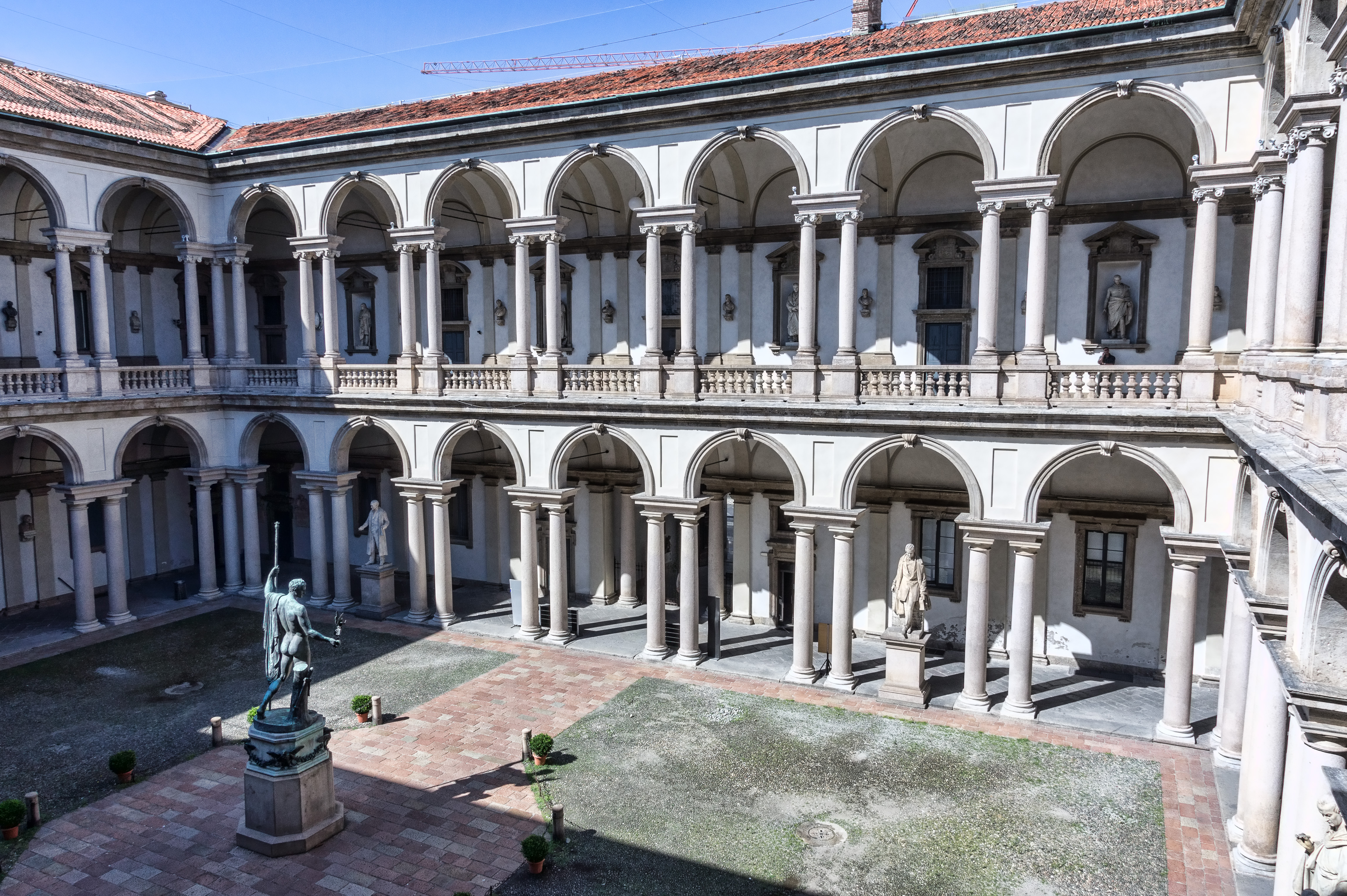|
The Adoration Of The Kings (Bramantino)
''The Adoration of the Kings'' is a small oil painting on panel of by Bramantino in the National Gallery, London. In it the Holy Family and the Magi are, unusually, joined by an adult John the Baptist, whose Baptism of Jesus, Baptism of Christ was celebrated on the same day as Epiphany (holiday), Epiphany in the liturgical year, liturgical calendar. At 56.8 cm (22.4 in) × 55 cm (22 in), it was probably commissioned for private use by an individual rather than for placing in a church, but nothing is known about its early history. The panel entered the National Gallery in 1916 as part of the Layard Bequest. Bramantino was a painter in Milan, who is relatively little known outside northern Italy, where most of his paintings remain; this is the only known example in the United Kingdom. In a Milanese art scene dominated by Leonardo da Vinci, Bramantino instead belonged to a tradition of "the structured but immobile realism of the Quattrocento ... that was fundamen ... [...More Info...] [...Related Items...] OR: [Wikipedia] [Google] [Baidu] |
Adoration Of The Magi
The Adoration of the Magi or Adoration of the Kings is the name traditionally given to the subject in the Nativity of Jesus in art in which the three Magi, represented as kings, especially in the West, having found Jesus by following a star, lay before him gifts of gold, frankincense, and myrrh, and worship him. It is related in the Bible by Matthew 2:11: "On entering the house, they saw the child with Mary his mother; and they knelt down and paid him homage. Then, opening their treasure chests, they offered him gifts of gold, frankincense, and myrrh. And having been warned in a dream not to return to Herod, they left for their own country by another path". Christian iconography considerably expanded the bare account of the Biblical Magi described in the Gospel of Matthew ( 2:1– 22). By the later Middle Ages this drew from non-canonical sources like the Golden Legend by Jacobus de Voragine. Artists used the expanded Christian iconography to reinforce the idea that J ... [...More Info...] [...Related Items...] OR: [Wikipedia] [Google] [Baidu] |
Gesso
Gesso (; "chalk", from the la, gypsum, from el, γύψος) is a white paint mixture consisting of a binder mixed with chalk, gypsum, pigment, or any combination of these. It is used in painting as a preparation for any number of substrates such as wood panels, canvas and sculpture as a base for paint and other materials that are applied over it. Description "''Gesso''", also known "glue gesso" or "Italian gesso", is a traditional mix of an animal glue binder (usually rabbit-skin glue), chalk, and white pigment, used to coat rigid surfaces such as wooden painting panels or masonite as a permanent absorbent primer substrate for painting. The colour of gesso is usually white or off-white. Its absorbency makes it work with all painting media, including water-based media, different types of tempera and oil paint. It is also used as a base on three-dimensional surfaces for the application of paint or gold leaf. Mixing and applying it is a craft in itself, as it is usually applie ... [...More Info...] [...Related Items...] OR: [Wikipedia] [Google] [Baidu] |
Perspective (graphical)
Linear or point-projection perspective (from la, perspicere 'to see through') is one of two types of 3D projection, graphical projection perspective in the graphic arts; the other is parallel projection. Linear perspective is an approximate representation, generally on a flat surface, of an image as it is seen by the eye. Perspective drawing is useful for representing a three-dimensional scene in a two-dimensional medium, like paper. The most characteristic features of linear perspective are that objects appear smaller as their distance from the observer increases, and that they are subject to ''foreshortening'', meaning that an object's dimensions along the line of sight appear shorter than its dimensions across the line of sight. All objects will recede to points in the distance, usually along the horizon line, but also above and below the horizon line depending on the view used. Italian Renaissance painters and architects including Masaccio, Paolo Uccello, Piero della Fran ... [...More Info...] [...Related Items...] OR: [Wikipedia] [Google] [Baidu] |
Christian Interpretations Of Virgil's Eclogue 4
''Eclogue'' 4, also known as the Fourth ''Eclogue'', is the name of a Latin poem by the Roman poet Virgil. Part of his first major work, the ''Eclogues'', the piece was written around 40 BC, during a time of brief stability following the Treaty of Brundisium; it was later published in and around the years 39–38 BC. The work describes the birth of a boy, a supposed savior, who once of age will become divine and eventually rule over the world. During late antiquity and the Middle Ages, a desire emerged to view Virgil as a virtuous pagan, and as such, early Christians, such as Roman Emperor Constantine, early Christian theologian Lactantius, and St. Augustineto varying degreesreinterpreted the poem to be about the birth of Jesus Christ. This belief persisted into the Medieval era, with many scholars arguing that Virgil not only prophesied Christ prior to his birth but also that he was a pre-Christian prophet. Dante Alighieri included Virgil as a main character in his ''Divine ... [...More Info...] [...Related Items...] OR: [Wikipedia] [Google] [Baidu] |
Virgil
Publius Vergilius Maro (; traditional dates 15 October 7021 September 19 BC), usually called Virgil or Vergil ( ) in English, was an ancient Roman poet of the Augustan period. He composed three of the most famous poems in Latin literature: the ''Eclogues'' (or ''Bucolics''), the ''Georgics'', and the epic ''Aeneid''. A number of minor poems, collected in the ''Appendix Vergiliana'', were attributed to him in ancient times, but modern scholars consider his authorship of these poems as dubious. Virgil's work has had wide and deep influence on Western literature, most notably Dante's ''Divine Comedy'', in which Virgil appears as the author's guide through Hell and Purgatory. Virgil has been traditionally ranked as one of Rome's greatest poets. His ''Aeneid'' is also considered a national epic of ancient Rome, a title held since composition. Life and works Birth and biographical tradition Virgil's biographical tradition is thought to depend on a lost biography by the Roman ... [...More Info...] [...Related Items...] OR: [Wikipedia] [Google] [Baidu] |
Augustus
Caesar Augustus (born Gaius Octavius; 23 September 63 BC – 19 August AD 14), also known as Octavian, was the first Roman emperor; he reigned from 27 BC until his death in AD 14. He is known for being the founder of the Roman Principate, which is the first phase of the Roman Empire, and Augustus is considered one of the greatest leaders in human history. The reign of Augustus initiated an imperial cult as well as an era associated with imperial peace, the ''Pax Romana'' or ''Pax Augusta''. The Roman world was largely free from large-scale conflict for more than two centuries despite continuous wars of imperial expansion on the empire's frontiers and the year-long civil war known as the "Year of the Four Emperors" over the imperial succession. Originally named Gaius Octavius, he was born into an old and wealthy equestrian branch of the plebeian ''gens'' Octavia. His maternal great-uncle Julius Caesar was assassinated in 44 BC, and Octavius was named in Caesar' ... [...More Info...] [...Related Items...] OR: [Wikipedia] [Google] [Baidu] |
Apollo
Apollo, grc, Ἀπόλλωνος, Apóllōnos, label=genitive , ; , grc-dor, Ἀπέλλων, Apéllōn, ; grc, Ἀπείλων, Apeílōn, label=Arcadocypriot Greek, ; grc-aeo, Ἄπλουν, Áploun, la, Apollō, la, Apollinis, label=genitive, , ; , is one of the Olympian deities in classical Greek and Roman religion and Greek and Roman mythology. The national divinity of the Greeks, Apollo has been recognized as a god of archery, music and dance, truth and prophecy, healing and diseases, the Sun and light, poetry, and more. One of the most important and complex of the Greek gods, he is the son of Zeus and Leto, and the twin brother of Artemis, goddess of the hunt. Seen as the most beautiful god and the ideal of the ''kouros'' (ephebe, or a beardless, athletic youth), Apollo is considered to be the most Greek of all the gods. Apollo is known in Greek-influenced Etruscan mythology as ''Apulu''. As the patron deity of Delphi (''Apollo Pythios''), Apollo is an oracul ... [...More Info...] [...Related Items...] OR: [Wikipedia] [Google] [Baidu] |
Tiburtine Sibyl
The Tiburtine Sibyl or Albunea was a Roman sibyl, whose seat was the ancient Etruscan town of Tibur (modern Tivoli). The mythic meeting of Cæsar Augustus with the Sibyl, of whom he inquired whether he should be worshiped as a god, was often depicted by artists from the late Middle Ages onwards. In the versions known to the later Middle Ages, for example the account in the ''Golden Legend'', Augustus asked the Sibyl whether he should be worshipped as a god, as the Roman Senate had ordered. She replied by showing him a vision of a young woman with a baby boy, high in the sky, while a voice from the heavens said "This is the virgin who shall conceive the saviour of the world", who would eclipse all the Roman gods. The episode was regarded as a prefiguration of the Biblical Magi's visit to the new-born Jesus and connected Ancient and Christian Rome, implying foreknowledge of the coming of Christ by the greatest of Roman emperors. Whether the sibyl in question was the Etruscan S ... [...More Info...] [...Related Items...] OR: [Wikipedia] [Google] [Baidu] |
Pinacoteca Ambrosiana
A pinacotheca (Latin borrowing from grc, πινακοθήκη, pinakothēkē = grc, πίναξ, pinax, (painted) board, tablet, label=none + grc, θήκη, thēkē, box, chest, label=none) was a picture gallery in either ancient Greece or ancient Rome. The name is specifically used for the building containing pictures which formed the left wing of the Propylaea on the Acropolis at Athens, Greece. The Pinacotheca was located next to the temple of Athena Nike. Though Pausanias speaks of the pictures "which time had not effaced",Pausanias, ''Description of Greece''book I, chapter xxii, page 31, section 6 translated by J. G. Frazer (1898) which seems to point to fresco painting, the fact that there is no trace of preparation for stucco on the walls implies that the paintings were easel pictures. The Romans adopted the term for the room in a private house containing pictures, statues, and other works of art. In the modern world the word is often used as a name for a public art g ... [...More Info...] [...Related Items...] OR: [Wikipedia] [Google] [Baidu] |
Adoration Of The Christ Child (Bramantino)
''Adoration of the Christ Child'' is a painting in tempera and oils of by Bramantino in the Pinacoteca Ambrosiana, Milan. Produced for an unknown commissioner from Milan, it shows the Christ Child being adored by the kneeling figures of Bernardino of Siena (recognisable by his grey Franciscan habit), Francis of Assisi (with his stigmata), Benedict of Nursia (in a black Benedictine habit) and the Virgin Mary. Behind them is a group of angel musicians standing on a column base. On the far left and right of the painting are the emperor Augustus and a sibyl in standing poses based on that of the '' Pothos'' sculpture. Their presence and that of a Roman arch in the background refer to a passage in the ''Golden Legend The ''Golden Legend'' (Latin: ''Legenda aurea'' or ''Legenda sanctorum'') is a collection of hagiographies by Jacobus de Voragine that was widely read in late medieval Europe. More than a thousand manuscripts of the text have survived.Hilary ...'' (1.40) in whi ... [...More Info...] [...Related Items...] OR: [Wikipedia] [Google] [Baidu] |







_Proffwydoliaeth_Sibli_Ddoeth.jpg)
